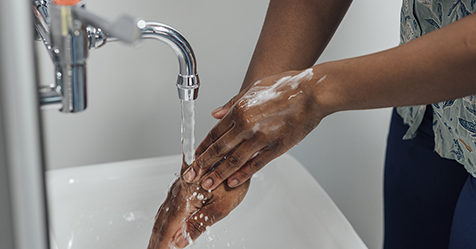In any busy building—whether a school, hospital, retail space, or office building—the flooring tells a story. Each scuff mark, dent, and worn patch records footsteps taken, carts wheeled, and furniture moved. But just like any hardworking part of a building, floors deserve care, attention, and, sometimes, a second chance.
As budgets tighten and sustainability becomes increasingly more critical, facilities are rethinking how to manage their spaces. Once seen as an afterthought, flooring is now at the forefront of
building maintenance and management. Facility managers are finding that preventive cleaning strategies and floor renewal systems can not only extend the life of flooring but also save time and
resources and lessen environmental impact.
Cleaning: The first line of defense
The journey to a longer, hard-surface floor life starts with daily cleaning. Regular cleaning keeps floors looking sharp, protects the finish’s integrity, and extends the floor’s life.
The right cleaning routine keeps dirt, grit, and bacteria from building up on hardwood and resilient floors (like vinyl, luxury vinyl tile (LVT), linoleum, and rubber). Start by mapping out a cleaning route that keeps maintenance teams moving forward and avoids backtracking to increase efficiency and reduce the chances of spreading debris.
Next, dry mop with a microfiber mop to trap allergens and debris, while also saving water. Choose bio-based, pH-neutral cleaning solutions that are free of dyes and other harmful ingredients.
These gentle yet effective cleaning solutions will help maintain the flooring finish with minimal impact on indoor air quality (IAQ) or the environment, unlike some acidic, all-purpose cleaning solutions that are harsh on floors.
As a finishing touch, place floor mats in high-traffic zones to trap dirt and debris from shoes before it hits the floor. Protect floors from sun damage by rearranging furniture or installing window shades to prevent fading and ultraviolet (UV) light damage. Use area rugs, felt, or rubber pads under furniture legs to avoid scratches and accidental damage.
Recoating: A gentle reset
Eventually, even well-maintained floors begin to show signs of wear. That’s where recoating comes in.
Recoating involves lightly abrading the existing finish—no deep sanding or demolition required—and applying a fresh topcoat. This process works for hardwood and resilient floors, giving them a
polished look and renewed protection. This step is the perfect middle-ground solution for floors with minor scratches or dullness, offering a cost-effective way to maintain aesthetics and hygiene
without starting from scratch.
For resilient flooring, recoating creates a seamless, monolithic surface that forms a barrier to seal gaps and corners, preventing bacteria and moisture from settling. This smooth finish is not
only easy to clean but also meets strict safety and health standards, improving the overall quality of the indoor environment.
To lessen your facility’s environmental impact, consider using waterborne recoating products and systems certified as sustainable choices by a third party.
Refinishing: A floor’s second life
Refinishing a damaged or outdated hard flooring surface will give it a new life.
Hardwood refinishing is a time-tested process. The surface is sanded down to remove stains, wear, and imperfections. Then, work crews apply a new stain, sealer, and finish, transforming tired floors. This refinishing also allows updating of colors or textures in a space, aligning design with purpose.
In the past, worn resilient flooring would be torn out, sent to the landfill, and replaced at great cost. However, today’s floor renewal systems include formulations for resilient flooring. These
systems can completely transform a damaged or run-down resilient floor and are available in various colors and textures.
Flooring renewal can offer savings on multiple fronts. An IVL Swedish Environmental Research Institute study found that renewing floors can reduce a facility’s carbon footprint by up to 92% and energy use by 95% compared to full replacement. In addition, these systems can reduce a facility’s downtime, labor needs, and overall costs.
For example, a Washington hospital renovated a labor and delivery room floor in 18 hours, saving 75% in costs and avoiding three days of downtime. A retailer in Michigan refreshed 2,500 square
feet in just five hours—without closing its doors for even one minute—eliminating potential lost revenues.
Teamwork: Choosing workers and materials
A good floor renewal story starts with the right surface and ends with the right products and team. Training maintenance staff to understand flooring types and how to care for them ensures longevity. Using certified flooring professionals for installations or refinishing reduces the risk of costly mistakes. Products and systems that consider environmental concerns—waterborne
finishes and stains with low levels of volatile organic compounds (VOCs)—can go a long way to lessening the impact.
Millions of square feet of flooring are discarded yearly—floors that could have been renewed, not replaced. With the ability to refinish hardwood and resilient flooring, facilities can complete renovation faster, for less cost, and use a better method for the environment. This prevents landfill waste and aligns with larger sustainability goals as facilities look to reduce their environmental footprint.
Ensuring a long lifespan
Whether your facility’s floors are hardwood or resilient, new or old, a regular maintenance plan goes a long way to keep your floor care operations running smoothly. Additionally, innovative new
products and systems can prevent the high cost of floor replacement. Together, a solid maintenance plan supplemented by occasional floor renewal can reduce costs, lessen environmental impact,
and extend the lifespan of your floors.



